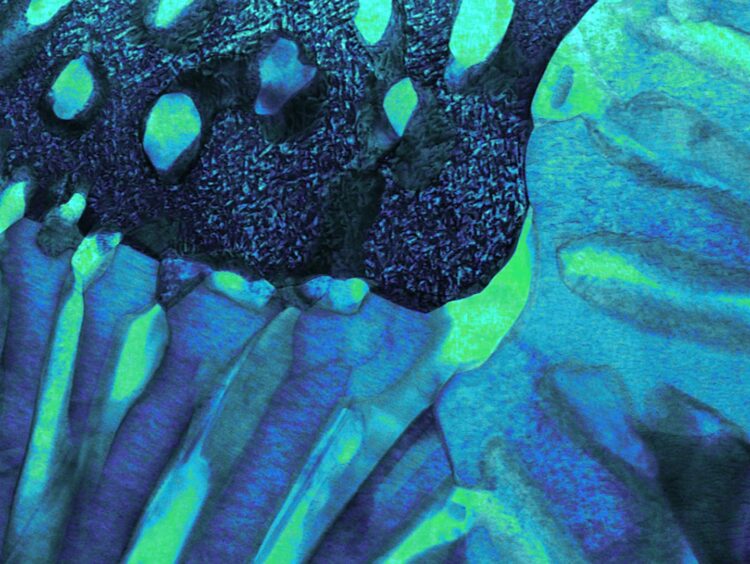
Credit: ORNL/U.S. Dept. of Energy
Manufacturing – Mighty Mo
Oak Ridge National Laboratory scientists proved molybdenum titanium carbide, a refractory metal alloy that can withstand extreme temperature environments, can also be crack free and dense when produced with electron beam powder bed fusion. Their finding indicates the material’s viability in additive manufacturing.
Molybdenum, or Mo, as well as associated alloys, are difficult to process through traditional manufacturing because of their high melting temperature, reactivity with oxygen and brittleness.
To address these shortcomings, the team formed a Mo metal matrix composite by mixing molybdenum and titanium carbide powders and used an electron beam to melt the mixture, which demonstrated the ability to control the cooling rate to optimize performance.
“Our results showed that fabrication from a mechanically alloyed metal matrix composite powder is feasible,” ORNL’s Mike Kirka said. “The structures formed by the fused powders can withstand high temperatures, indicating that molybdenum and its alloys can be used for aerospace and energy conversion applications.”
Media contact: Jennifer Burke, 865.414.6835, [email protected]
Image: https:/
Caption: ORNL researchers used electron beam powder bed fusion to produce refractory metal molybdenum, which remained crack free and dense, proving its viability for additive manufacturing applications. Credit: ORNL/U.S. Dept. of Energy
Tech transfer – Fueling retooling
In a new twist to an existing award-winning ORNL technology, researchers have developed an electrocatalyst that enables water and carbon dioxide to be split and the atoms recombined to form higher weight hydrocarbons for gasoline, diesel and jet fuel.
The technology is a carbon nanospike catalyst that uses nanoparticles of a custom-designed alloy, which has been licensed by California-based Prometheus Fuels. The spiky textured surface of the catalysts provides ample reactive sites to facilitate the carbon dioxide-to-hydrocarbons conversion.
“This cutting-edge catalyst will enable us to further lower the price of our zero net carbon fuels,” said Rob McGinnis, CEO and founder of Prometheus.
The company plans to use the technology in its process for converting electricity from solar and wind into chemical energy to make zero net carbon electrofuels.
The carbon nanospike catalyst was invented using a one-of-a-kind nanofabrication instrument and staff expertise at ORNL’s Center for Nanophase Materials Sciences.
Media contact: Karen Dunlap, 865.696.5910, [email protected]
Image: https:/
Caption: ORNL researchers have developed an electrocatalyst made of custom-designed alloy nanoparticles embedded in carbon nanospikes. This image, made with a transmission electron microscope, shows the carbon nanospikes. Credit: Adam Rondinone and Dale Hensley/ORNL, U.S. Dept. of Energy
Transportation – Keep on truckin’
A newly released dataset that tracks the movement of everything from food to gasoline across the United States by air, water, truck, rail and pipeline showed the value and tonnage of those goods rose significantly between 2012 and 2017.
The Freight Analysis Framework, or FAF, is the most comprehensive public database of freight movement in the country, compiled by Oak Ridge National Laboratory and released every five years by the U.S. Department of Transportation.
The recent release, FAF5, revealed that 20 billion tons of U.S. goods valued at nearly $19 trillion were moved in 2017 compared with 17 billion tons valued at about $18 trillion in 2012. Trucks consistently transport about 64% of that freight.
“We help DOT build a comprehensive picture of where and how goods traveled and what commodities are being moved. The goal is to provide federal and state planners with critical data to inform infrastructure investment decisions,” said ORNL’s Ho-Ling Hwang.
Media contact: Stephanie Seay, 865.576.9894, [email protected]
Image: https:/
Caption: Public and private planners can use a FAF5 online tool to create maps to visualize the flow of goods into and across the U.S., for example, when making critical transportation infrastructure and equipment decisions. Credit: Hyeonsup Lim, ORNL/U.S. Dept. of Energy
Buildings – Concrete on the double
A team of researchers at Oak Ridge National Laboratory and the University of Tennessee have developed a concrete mix that demonstrated high early strength within six hours of mixing, potentially doubling the production capacity for the precast industry.
Quick performing concrete shortens manufacturing time for prefabricated assemblies such as walls, beams and floor slabs. However, early-strength mixes have short setting times and require specific curing methods.
In a study, researchers evaluated commercially available components including steel, glass and carbon fibers. The result was a self-compacting mix that not only showed early strength but also maintained its workability for 30 minutes.
“We followed a practical, cost-effective process easily implemented with typical mixing procedures,” ORNL’s Diana Hun said. “This could enable precast plants to cast twice per day.”
Future research includes decreasing the amount of carbon embodied in the mix. The study was conducted in collaboration with the Precast/Prestressed Concrete Institute.
Media contact: Jennifer Burke, 865.414.6835, [email protected]
Image: https:/
Caption: ORNL researchers used fiber reinforcements made of steel, glass and carbon to develop a concrete mix that demonstrated high early strength within six hours of production, which is needed for the precast concrete industry. Credit: ORNL/U.S. Dept. of Energy
Image: https:/
Caption: Researchers from ORNL and the University of Tennessee collaborated to perform lab-scale evaluations on the high early strength fiber-reinforced self-compacting concrete mix. Credit: University of Tennessee
Recycling – A batteries passport
Scientists at Oak Ridge National Laboratory have devised a method to identify the unique chemical makeup of every lithium-ion battery around the world, information that could accelerate recycling, recover critical materials and resolve a growing waste stream.
Similar to how plastics are stamped with a recycling code identifying their makeup, Li-ion batteries could be encoded with what ORNL researchers described as a Battery Identity Global Passport, which could be accessible as a scannable QR code or a computer chip. This method could help recyclers more efficiently locate in-demand materials and accommodate the wide variety of designs used to manufacture Li-ion batteries.
“This passport can help recyclers contend with the mixed stream of materials since there’s no standard cell chemistry now for Li-ion battery production,” said ORNL’s Ilias Belharouak. “The challenge is growing as we see more of these batteries used in electric vehicles, for energy storage and in electronic devices.”
Media contact: Stephanie Seay, 865.576.9894, [email protected]
Image: https:/
Caption: The proposed Battery Identity Global Passport suggests a scannable QR code or other digital tag affixed to Li-ion batteries to identify materials for efficient end-of-life recycling. Credit: Andy Sproles, ORNL/U.S. Dept. of Energy
###
Media Contact
Sara Shoemaker
[email protected]
Original Source
https:/
Related Journal Article
http://dx.





